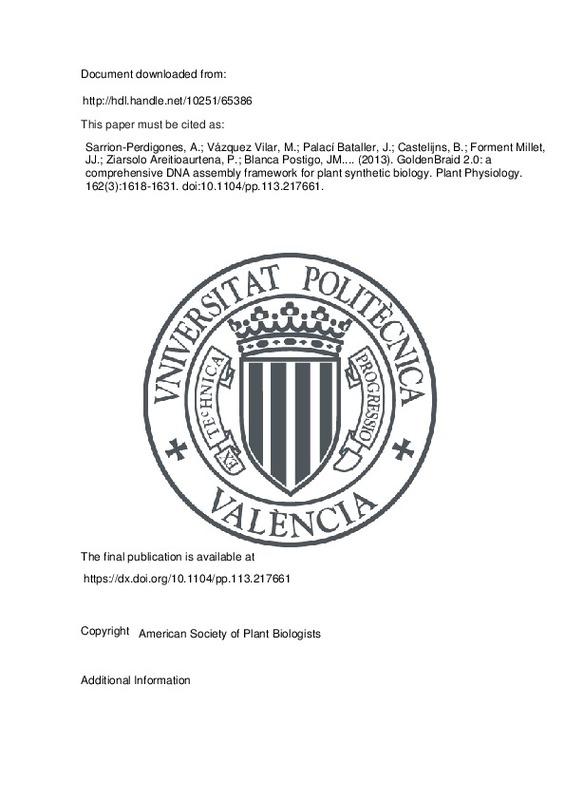Sarrion-Perdigones, A.; Vázquez Vilar, M.; Palací Bataller, J.; Castelijns, B.; Forment Millet, JJ.; Ziarsolo Areitioaurtena, P.; Blanca Postigo, JM.... (2013). GoldenBraid 2.0: a comprehensive DNA assembly framework for plant synthetic biology. Plant Physiology. 162(3):1618-1631. https://doi.org/10.1104/pp.113.217661
Por favor, use este identificador para citar o enlazar este ítem: http://hdl.handle.net/10251/65386
|
Título:
|
GoldenBraid 2.0: a comprehensive DNA assembly framework for plant synthetic biology
|
|
Autor:
|
Sarrion-Perdigones, Alejandro
Vázquez Vilar, Marta
Palací Bataller, Jorge
Castelijns, Bas

 Forment Millet, José Javier
Forment Millet, José Javier
 Ziarsolo Areitioaurtena, Pello
Ziarsolo Areitioaurtena, Pello

 Blanca Postigo, José Miguel
Blanca Postigo, José Miguel

 Granell Richart, Antonio
Granell Richart, Antonio
 Orzáez Calatayud, Diego Vicente
Orzáez Calatayud, Diego Vicente
|
|
Entidad UPV:
|
Universitat Politècnica de València. Departamento de Biotecnología - Departament de Biotecnologia
Universitat Politècnica de València. Instituto Universitario de Conservación y Mejora de la Agrodiversidad Valenciana - Institut Universitari de Conservació i Millora de l'Agrodiversitat Valenciana
|
|
Fecha difusión:
|
|
|
Resumen:
|
[EN] Plant synthetic biology aims to apply engineering principles to plant genetic design. One strategic requirement of plant synthetic biology is the adoption of common standardized technologies that facilitate the ...[+]
[EN] Plant synthetic biology aims to apply engineering principles to plant genetic design. One strategic requirement of plant synthetic biology is the adoption of common standardized technologies that facilitate the construction of increasingly complex multigene structures at the DNA level while enabling the exchange of genetic building blocks among plant bioengineers. Here, we describe GoldenBraid 2.0 (GB2.0), a comprehensive technological framework that aims to foster the exchange of standard DNA parts for plant synthetic biology. GB2.0 relies on the use of type IIS restriction enzymes for DNA assembly and proposes a modular cloning schema with positional notation that resembles the grammar of natural languages. Apart from providing an optimized cloning strategy that generates fully exchangeable genetic elements for multigene engineering, the GB2.0 toolkit offers an ever-growing open collection of DNA parts, including a group of functionally tested, premade genetic modules to build frequently used modules like constitutive and inducible expression cassettes, endogenous gene silencing and protein-protein interaction tools, etc. Use of the GB2.0 framework is facilitated by a number of Web resources that include a publicly available database, tutorials, and a software package that provides in silico simulations and laboratory protocols for GB2.0 part domestication and multigene engineering. In short, GB2.0 provides a framework to exchange both information and physical DNA elements among bioengineers to help implement plant synthetic biology projects.
[-]
|
|
Palabras clave:
|
Arabidopsis-Thaliana
,
PCR products
,
One-pot
,
Transformation
,
Cloning
,
Expression
,
Libraries
,
Vectors
,
Pathway
,
System
|
|
Derechos de uso:
|
Reserva de todos los derechos
|
|
Fuente:
|
Plant Physiology. (issn:
0032-0889
)
|
|
DOI:
|
10.1104/pp.113.217661
|
|
Editorial:
|
American Society of Plant Biologists
|
|
Versión del editor:
|
https://dx.doi.org/10.1104/pp.113.217661
|
|
Código del Proyecto:
|
info:eu-repo/grantAgreement/MICINN//BIO2010-15384/ES/FABRICANDO TOMATES SALUDABLES: BIOPIEZAS PARA INTRAGENESIS Y MOLECULAR FARMING EN SOLANACEAS/
|
|
Agradecimientos:
|
This work was supported by the Spanish Ministry of Economy and Competitiveness (grant no. BIO2010-15384), by a Research Personnel in Training fellowship to A.S.-P., and by a Junta de Ampliacion de Estudios fellowship to M.V.-V.[+]
This work was supported by the Spanish Ministry of Economy and Competitiveness (grant no. BIO2010-15384), by a Research Personnel in Training fellowship to A.S.-P., and by a Junta de Ampliacion de Estudios fellowship to M.V.-V.
[-]
|
|
Tipo:
|
Artículo
|







![[Cerrado]](/themes/UPV/images/candado.png)


